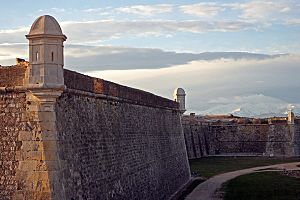Sant Ferran Castle facts for kids
Quick facts for kids Sant Ferran Castle |
|
|---|---|
| Catalan: Castell de Sant Ferran Spanish: Castillo de San Fernando. |
|
| Figueres, Spain | |
 |
|
| Type | Castle |
| Site information | |
| Open to the public |
Yes |
| Site history | |
| Built | 1753 |
| Built by | Pedro Martín Cermeño and Juan Martín Cermeño |
| Materials | Stone and Brick |
The Sant Ferran Castle (also known as Catalan: Castell de Sant Ferran in Catalan and Spanish: Castillo de San Fernando in Spanish) is a huge military fort. It stands on a hill in Figueres, a town in Catalonia, Spain. This impressive castle was built in the 1700s. Important military engineers like Pedro Martín Cermeño and Juan Martín Cermeño helped design it. Today, it is the biggest historical building in Catalonia.
Contents
History of Sant Ferran Castle
Why the Castle Was Built
After the Treaty of the Pyrenees in 1659, a fort called Fort de Bellegarde became part of France. This fort used to protect Spain's border. To replace it and guard against future attacks, Spain decided to build a new fortress. They chose a hill in Figueres for its location.
The first stone of the castle was laid on December 13, 1753. The castle was named Sant Ferran (San Fernando in Spanish). This name honored King Ferdinand VI of Spain.
The Castle During Wars
The castle was captured by the French early in the Peninsular War. This war with France started in 1808.
On January 9, 1810, a Spanish hero named Mariano Álvarez de Castro was brought to Sant Ferran. He had been a leader in the recent third siege of Girona. He was imprisoned at the castle. The next day, he was found dead. The French said he died of a fever. However, many Spanish people believed he was poisoned. He was buried simply in the castle cemetery.
In 1815, a special black marble plaque was placed on his grave. It said that Álvarez had been poisoned. It called him a "Victim of the Iniquity of the French Tyrant." Years later, in December 1823, French troops came through Figueres. They were in Spain to help King Ferdinand VII. On the orders of Marshal Moncey, they destroyed the plaque.
Later Events at the Castle
On February 1, 1939, Juan Negrín held an important meeting at the castle. He was the last prime minister of the Second Spanish Republic. This was the final meeting of the Republican Spanish Parliament (Cortes) on Spanish land. Just one week later, the castle was taken over by the forces of Francisco Franco.
From May 1940 to December 1942, the castle was used as a holding place. People who had returned from France were kept there. Thousands of prisoners were held in the castle. Most of them were later sent to other camps.
Architecture and Size of the Castle
The Sant Ferran Castle is very large. It covers an area of 320,000 square meters (about 79 acres). Its outer walls stretch for 3,120 meters (nearly 2 miles).
Underneath the main courtyard, there are huge tanks. These tanks can hold up to 10 million liters of water. At its busiest, the castle could house 6,000 soldiers.
The castle stopped being used as a prison in July 1997. After that, it was opened to the public. Visitors can now take guided tours. These tours show off the castle's features. They also highlight the clever building methods used by military engineers back then.
Visiting Sant Ferran Castle
The castle is located in the northwest part of Figueres. It is now easier for tourists to reach. The Figueres Vilafant train station opened on the western side of town. This station is just over 500 meters (about a third of a mile) from the castle. You can get there using a footpath.
See also
 In Spanish: Castillo de San Fernando (Figueras) para niños
In Spanish: Castillo de San Fernando (Figueras) para niños

